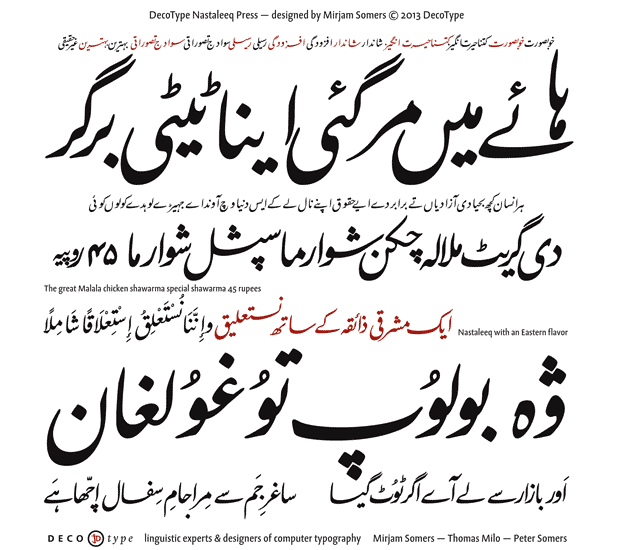TYPE DESIGN INFORMATION PAGE last updated on Tue Oct 28 09:21:28 EDT 2025
FONT RECOGNITION VIA FONT MOOSE
|
|
|
|
Mirjam Somers
Mirjam Somers was educated at St Joost Art Academy in Breda, The Netherlands, where her teachers included calligraphers Chris Brand and Jan van den Bouwhuysen. After two years she continued at the Gerrit Rietveld Academy in Amsterdam and graduated there in 1974 in Architectural Design. Having worked as a carpenter and free-lance typographer, she encountered Arabic script in 1982 when together with Thomas Milo she designed and produced the Arabic Letter Box, a wooden prototype of a computer program and an educational tool at once. With Tom she reduced the traditional Arabic Ruqah script to 70 penstrokes and defined a mechanism to generate all Arabic letter combinations by the smart font algorithm. The combination of the font-in-the-box and the out-of-the-box font inspired Peter Somers to write the smart font program code. Peter, Mirjam and Thomas incorporated Decotype [Designers of Computer-aided Typography] in 1985. Mirjam played a major role in designing the Naskh typeface (1993-2004), and created the Emiri (2004, a revival) and DecoType Nastaliq (2008-2010, an original analysis) typefaces. Her latest designs are a second Ruq'ah (2011) and an Eastern Nastaleeq (2012). DecoType Nastaliq (2009) won an award in the non-Latin category at TDC2 2010. Decotype Nastaleeq Press won an award at TDC 2014. The award blurb reads: DecoType Nastaliq is the latest fruit of more than 25 years of analyzing Arabic scripts in their pure, pre-typographic form. Like its close relative ruq?ah, nastaliq retains the original two-dimensional aspect of Arabic script. To capture this for use in an essentially Latin-based technical environment is a great challenge. The final glyph set consists of a minimal set of functional shapes, with which for all Arabic-scripted languages all imaginable combinations with any diacritic attachment can be generated. This is possible solely with the use of ACE, the Arabic Calligraphic Engine, a radical departure from conventional thinking in Gutenberg-style movable type. ACE was developed by the DecoType team, Thomas Milo, Peter Somers and Mirjam Somers, initially for the ruqah script, later it was expanded for a very broad analysis of the naskh script. Today ACE drives any Arabic typeface and is the core engine of WinSoft's Tasmeem enhancement of Adobe InDesign Middle Eastern version. The seminal role of ACE for the development of smart font technology, including OpenType, was recently acknowledged with the Dr Peter Karow Award. At ATypI 2011 in Reykjavik, she spoke on the slanted Arabic typefaces with cascading connections: It was exactly this challenge that brought DecoType into the typography scene in 1985 with the very first Ruqah computer typography. In 2011, a completely new Ruqah design takes its place. In addition to that, the award-winning DecoType Nastaliq typeface in Persian style is very well received as the top typeface in WinSoft Tasmeem. A second nastaliq, this time in Pakistani style is under construction. Speaker at ATypI 2013 in Amsterdam: Technology designed for Arabic. Ruq'ah (2011) won an award at TDC 2012. |
EXTERNAL LINKS |
| | |

file name: Mirjam Somers Deco Type Nastaleeq Press T D C Award 2014
| | |
|
Luc Devroye ⦿ School of Computer Science ⦿ McGill University Montreal, Canada H3A 2K6 ⦿ lucdevroye@gmail.com ⦿ https://luc.devroye.org ⦿ https://luc.devroye.org/fonts.html |
